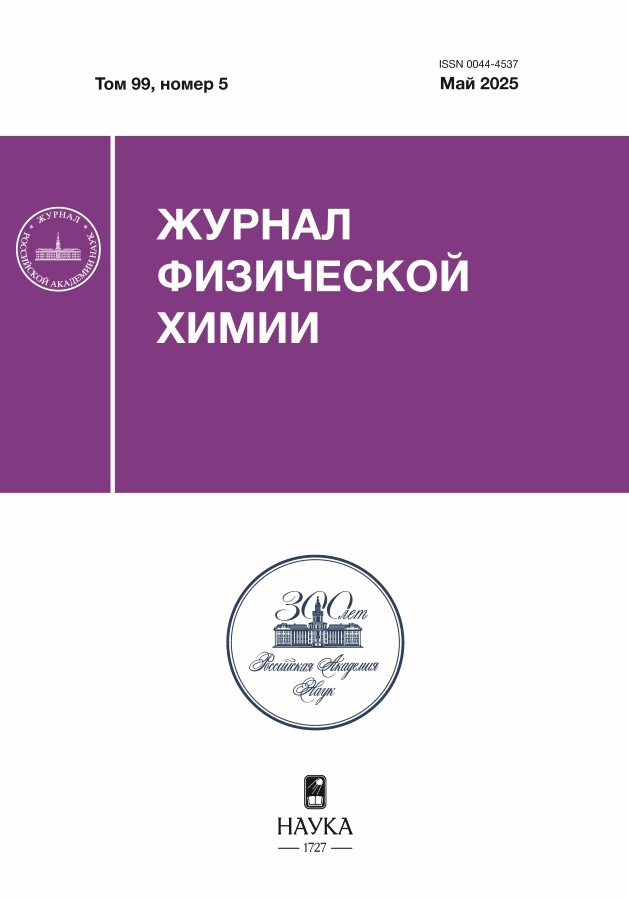Influence of the inductive effect on the protolytic properties of some aliphatic amino acids
- Авторлар: Samadov A.S.1, Khakimov D.N.1, Stepnova A.F.2, Faizullozoda E.F.1, Kuzin A.V.3
-
Мекемелер:
- Tajik National University
- Peoples’ Friendship University of Russia
- Moscow Pedagogical State University
- Шығарылым: Том 99, № 5 (2025)
- Беттер: 732-739
- Бөлім: PHYSICAL CHEMISTRY OF SOLUTIONS
- ##submission.dateSubmitted##: 22.09.2025
- ##submission.datePublished##: 15.12.2025
- URL: https://rjeid.com/0044-4537/article/view/691144
- DOI: https://doi.org/10.31857/S0044453725050078
- EDN: https://elibrary.ru/hexhru
- ID: 691144
Дәйексөз келтіру
Аннотация
The protolytic propertiesof a number of aliphatic amino acids, viz. serine (Ser),cysteine (Cys), glycine (Gly), alanine (Ala), valine (Val), leucine (Leu),and isoleucine (Ile) in aqueous solutions atT = 298.2 K andI = 0.1 mol/L NaNO3are studiedby pH monitoring. Using the calculated ionization constants of aminoacids and the equation allowing one to quantify the inductiveeffect in the aliphatic series (the Taft equation), the substituentconstantσ*is calculated, with its values showing a positivecorrelation with the ionization constants of amino acids (рKi) (R2= 0.9561 andR2= 0.8542). Theresults show that the acidity of the studied amino acidsdecreases as follows Cys > Ser > Gly > Gly> Leu > Ala > Ile > Val. The acid-baseproperties of amino acids are found to change depending onthe inductive effect (the radical constantσ*). Among thestudied amino acids, Cys exhibits the highest acidity and isconsidered to be the weakest base.
Негізгі сөздер
Авторлар туралы
A. Samadov
Tajik National University
Email: s.rasul@mail.ru
Dushanbe, 734025 Tajikistan
Dzh. Khakimov
Tajik National University
Email: s.rasul@mail.ru
Dushanbe, 734025 Tajikistan
A. Stepnova
Peoples’ Friendship University of Russia
Email: s.rasul@mail.ru
Moscow, 117198 Russia
E. Faizullozoda
Tajik National University
Email: s.rasul@mail.ru
Dushanbe, 734025 Tajikistan
A. Kuzin
Moscow Pedagogical State University
Хат алмасуға жауапты Автор.
Email: s.rasul@mail.ru
Moscow, 129164 Russia
Әдебиет тізімі
- Akram M., Asif H.M.,Uzair M., et al. // J. of Medicinal PlantsResearch. 2011. V. 5. № 17. P. 3997.
- ValdemirL., Zélia M. da CostaL., Danillo V.,et al. // J. of Molecular Liquids. 2020. P. 319. https://doi.org/10.1016/j.molliq.2020.114109
- Rand R.P. // Philos. Trans. R. Soc.Lond. Ser. B Biol. Sci. 2004. V. 359. P. 1277. https://doi.org/10.1098/rstb.2004.1504
- Adam C.L.,Gordon M.C. // J. Chem.Inf. Model. 2009. V. 49. P. 2013.
- Makowska J., Baginska K., Liwo A.,et al. // Peptide Science. 2008. V. 90. № 5. https://doi.org/10.1002/bip.21046
- Somaryn M.S., Gharib F. //J. of Applied Chemical Research. 2014. V. 8. № 3. P. 17.
- Subirats X.E., Rosés F.M., Bosch E., etal. // Molecular Sciences and Chemical Engineering, Elsevier 2015. https://doi.org/10.1016/B978-0-12-409547-2.11559-8
- Зеленин О.Ю.,Кочергина Л.А. // Журн. общ. химии. 2004. Т. 74. № 2. С. 230–234.
- Bretti C., Giuffrè O., Lando G., et al. // SpringerPlus. 2016. 5:928. https://doi.org/10.1186/s40064-016-2568-8
- Seza BastugA., Seda Goz E., TalmanY., et al. // J. of Coordination Chemistry. 2011. V. 64. № 2. P. 281. http://dx.doi.org/10.1080/00958972.2010.541454
- Clarke R.G.F.,Collins C.M., Roberts J.C., et al. // GeochimicaetCosmochimica Acta. 2004. V. 69. № 12. P. 3029. https://doi.org/10.1016/j.gca.2004.11.028
- Вандышев В.Н.,Леденков С.Ф. // Журн. физ. химии. 2009. Т. 83. № 12. С. 2384.
- Chernyshova О.S., Boichenko A.P.,Abdulrahman H., et al. // J. of MolecularLiquids. 2013. Р. 182. http://dx.doi.org/10.1016/j.molliq.2013.03.003
- Sharma V.K., CasteranF., Millero F.J., et al. // J. of Solution Chemistry. 2002. V.31. № 10. P. 783. https://doi.org/10.1023/a:1021389125799
- Zhu M., Yang D., Ye R., et al. // Catal.Sci. Technol. 2019. https://doi.org/10.1039/C9CY00102F.
- Chowdhury S., Mandal P., Hossain A., et al. // J. Chem. Eng. Data. 2019.V. 64. № 10. P. 4286. https://doi.org/10.1021/acs.jced.9b00363
- Glinskia J., Chavepeyerb G., Platten J. // Biophysical Chemistry 2000. V. 84. P. 99. https://doi.org/10.1016/S0301-4622(99)00150-7
- Горичев И.Г., Атанасян Т.К., Мирзоян П.И.Расчет констант кислотно-основныхсвойств наночастиц оксидных суспензий с помощью программ Mathсad.Учебное пособие. Москва. 2014. 57 с.
- Arcis H., Ferguson J.P., Cox J.S., et al. // Cite as: J. Phys. Chem. Ref. 2020. V. 49. https://doi.org/10.1063/1.5127662
- Кобилова Н.Х., Бобилова Ч.Х., Жабборова Д.Р. // Международный академическийвестник. 2019. № 1 (33). С. 89.
- Самадов А.С., Хакимов Дж.Н., Степнова А.Ф. // Журн. физ. химии.2023. Т. 97. № 4. С. 512. https://doi.org/10.31857/S004445372304026X
- Самадов А.С., Миронов И.В.,. Горичев И.Г. и др. // Журн.общ. химии. 2020. Т. 90. № 11. С. 1738. doi: 10.31857/S0044460X20110141
- Самадов А.С., Степнова А.Ф., Файзуллозода Э.Ф. и др. // Вecтн.Моск. ун-та. Сер. 2. Химия. 2023. Т. 64. № 3.
- Kochergina L.A.,Volkov A.V., Khokhlova E.A., et al. // Rus. J. of PhysicalChemistry. 2011. V. 85. № 5. P. 970.
- Martell A.E., Smith R.M. Aminocarboxylic Acids. Critical Stability Constants.1982. P. 1. https://doi.org/10.1007/978-1-4615-6761-5_1
- Zelenin O. Yu., Kochergina L.A. // Russian Journalof general chemistry. 2004. V. 74. № 2. P. 259
- Sovago I., KissT., Gergely A. // Pure & App. Chem. 1993. V.65. № 5. P. 1029. https://doi.org/10.1351/pac199365051029.
- Berthon G. // Pure & App. Chem. 1995. V. 67. № 7. P. 1117. https://doi.org/10.1351/pac199567071117
- Popoca J.L., Thoke H.S., Stock R.P., et al. // Biochemistryand Biophysics Reports. 2020. V. 24. № 100802. https://doi.org/10.1016/j.bbrep.2020.100802
- Cherkasov A.R., Galkin V.I., Cherkasov R.A. // Rus. Chemical Reviews. 1996. V. 65. № 8. P. 641. https://doi.org/10.1070/RC1996v065n08ABEH000227
- Kingsbury C.A. // Faculty Publications Chemistry Department. 2019. № 155. http://digitalcommons.unl.edu/chemfacpub/155
- Widing H.F., Levitt L.S. // Z. Naturforsch. 1979. V. 34b. P. 321. https://doi.org/10.1515/znb-1979-0236.
Қосымша файлдар









